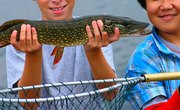
Raccoons are rambunctious mammals that can weigh up to 25 pounds. They normally like to be left alone; however, a mother raccoon defending her young or a cornered raccoon with no other escape will turn and fight with ferocity. They typically will find a hollow log, or abandoned animal den to make their homes in. Sometimes, a mother raccoon will nest in your attic, chimney or backyard, especially when she finds out that there is tasty human garbage ripe for the picking just a few feet away. Instead of paying a professional to remove the potentially dangerous animal, a homemade trap can be fashioned quite easily.
Items you will need
Barrel
2-by-4, 18 inches long
Find a barrel or round trash can. The taller the can, the better. It also needs to have smooth sides so the perpetrator can not get a grip once caught inside. Place the barrel near the edge of a table, or any flat surface taller than the lip of the can.
Pour water into the barrel. The barrel needs to be approximately 1/3 full, depending on the size of the raccoon. If your animal is smaller, use less water, as you don't want the critter to drown if you forget to check the trap in the morning.
Place the 18-inch section of 2-by-4 halfway onto the table and halfway hanging over the barrel. Make sure the end of the board is exactly centered in the middle of the barrel. You want to try and balance the board so that it will tip into the can when the raccoon walks across it.
Bait the trap. Place a tasty raccoon treat such as fish or peanut butter at the end of the board hanging over the barrel. The idea here is that the unsuspecting critter will "walk the plank" trying to get the food. It will then unbalance the board and go crashing down into the water. The water is a key component because, without it, the little sneak would jump and crawl right out of the barrel. When it splashes into the water, its fur becomes wet and heavy, and its claws loose all the traction they have in the wetness. Those two things combined mean that it will stay stuck in the barrel until you check it.
Writer Bio
Jack Powell has been writing professionally since 2008. He graduated from Red River College with a degree in creative communications and currently writes for a variety of local publications.



